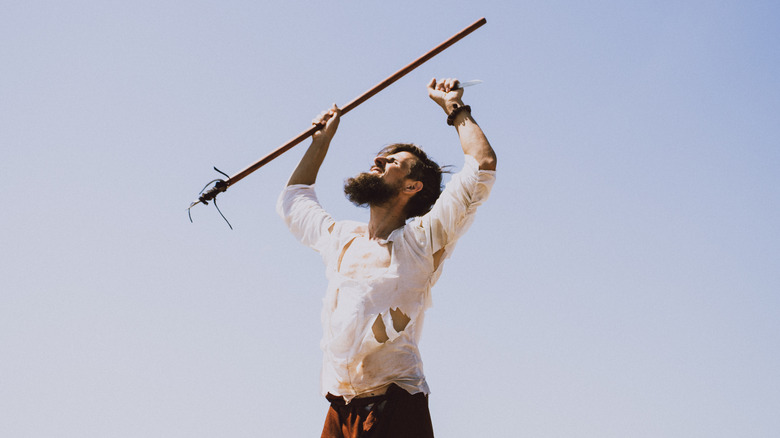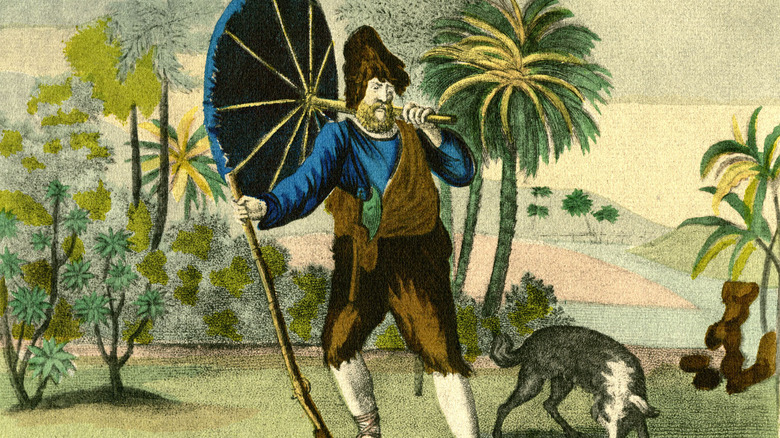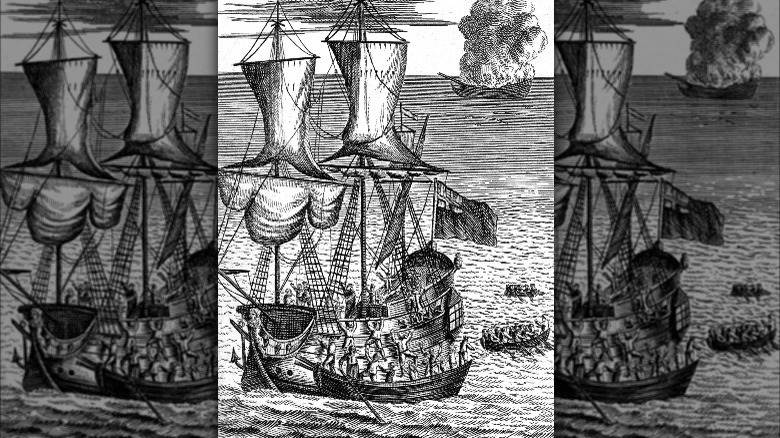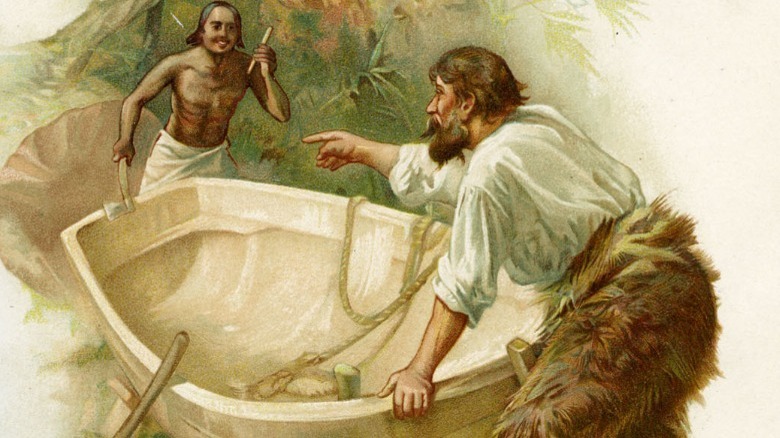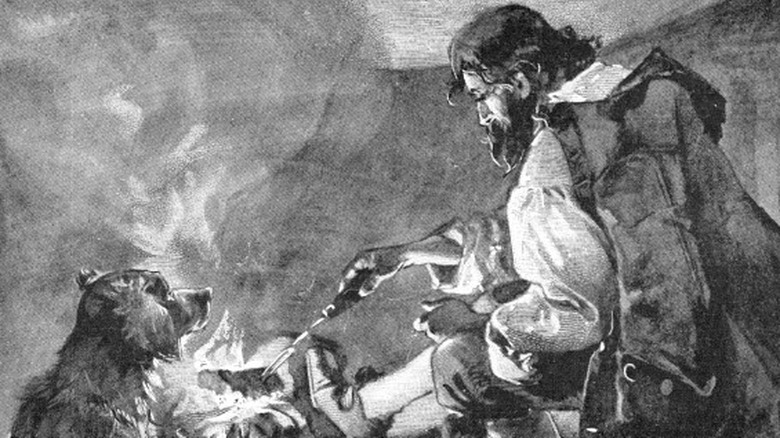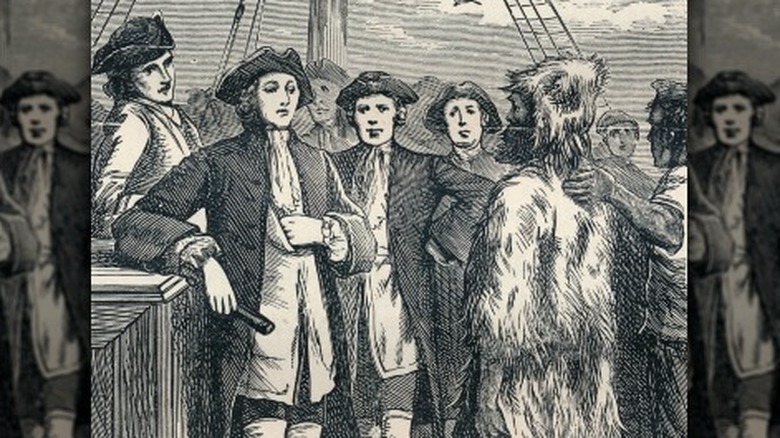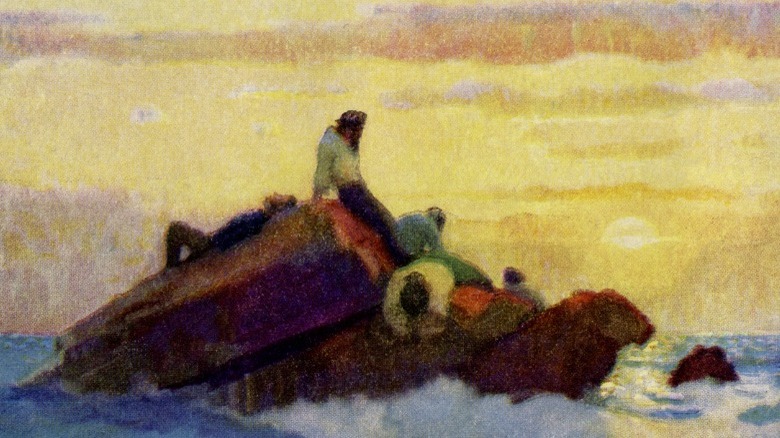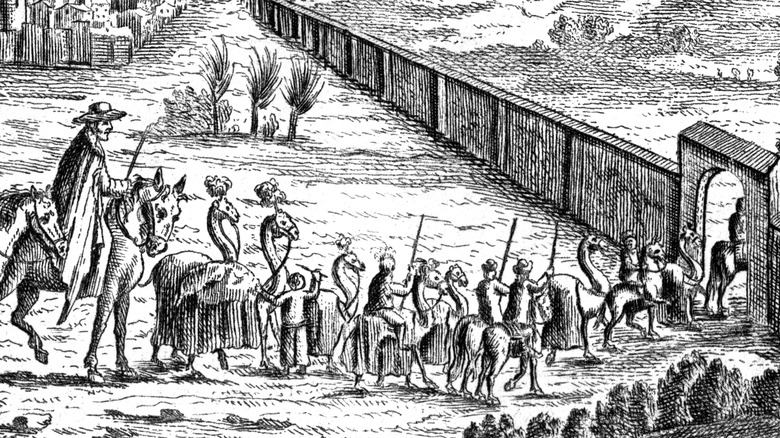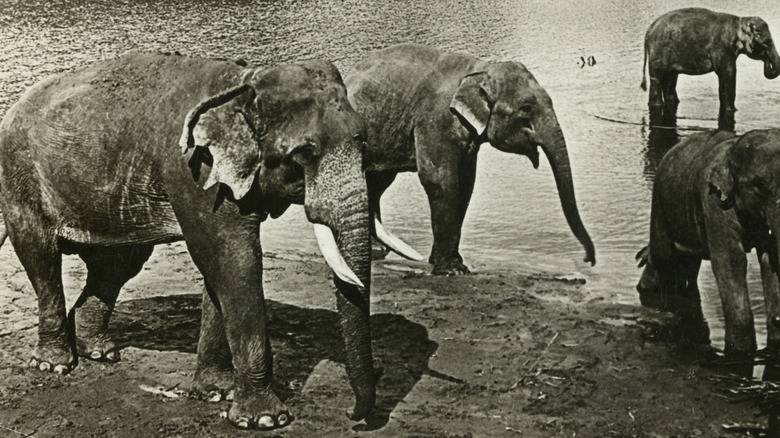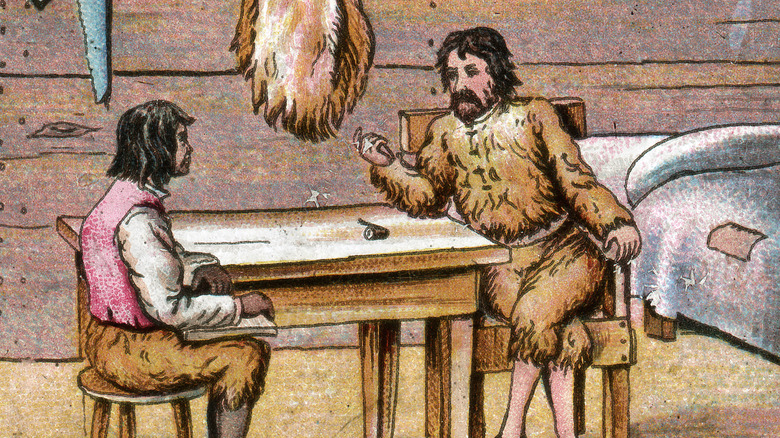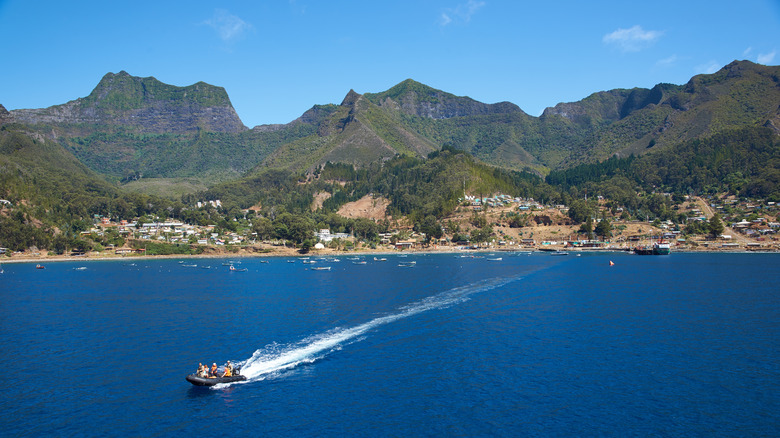The Real-Life Inspiration Behind Robinson Crusoe
"Robinson Crusoe," by Daniel Defoe, arguably the first English novel of all time (per the British Library), tells the story of one man — Crusoe — who just can't get enough of the sea. After two false starts that see him shipwrecked and then captured by pirates, Crusoe takes one more voyage. This time he ends up stuck on an island, the only human survivor of the wreck, alongside the captain's dog and two cats. What ensues from there is the wild story of survival spanning 28 years of Crusoe's life. He has run-ins with a native tribe, cannibals, and mutineers cast off by their own ship, per Britannica.
It's an adventure story told in autobiographical form, making it read like a true account of one massively unfortunate sailor. But in order for this story to sizzle with the plausibility that it does, it has to have roots in some pretty wild true stories of survival. And for Defoe, there were plenty to choose from. In a world where vessels traversed the sea every which way, piracy was rampant, mutiny was common, and the sheer number of uncharted islands was enormous, you can bet that there were plenty of castaways — some of whom even survived — with their own tales to tell.
The thing is, there is no single source that appears to be the primary inspiration, despite what you may think from reading the novel. Instead, there are numerous sources, so let's look at two of the most probable real-life inspirations for "Robinson Crusoe."
Inspiration #1: Alexander Selkirk
The man that is widely believed to be the main inspiration behind Robinson Crusoe's story, Alexander Selkirk, had his own tall tale of a life. He, like so many of his time, ran away from what little home he had and sought a life at sea from a very young age, according to Britannica. His life story actually reads rather anticlimactically compared to Crusoe's. Selkirk ran off, became a pirate, mutinied, and then spent four years on an island before he was rescued.
One of the most memorable moments of "Robinson Crusoe" is when Crusoe discovers the cannibals who eat prisoners on the island. Initially, he wants to kill them for what he perceives as their crimes, but then he realizes that the cannibals do not know any better. They don't know that they've done any wrong. So he calls off his plans, and his philosophical quandary of whether this was the right thing to do ensues.
So to put things bluntly, all signs point to Selkirk not being so open-minded, according to Smithsonian Magazine. In fact, he was something of a hard-headed brawler who wasn't exactly good at keeping company. He frequently got in fights, including with his father and brother, and he abandoned two women, both of whom thought they were his wife. When he was aboard the ship with William Dampier, he led the mutiny, but was surprised when no one joined him.
The fateful voyage
One of several differences that Alexander Selkirk has with the character Robinson Crusoe is the manner of the voyage they took. Remember, Crusoe took two previous voyages, and had a pretty decent life mixed with a few outings of bad luck, before he was left stranded on a deserted island with cannibals, per Britannica. Selkirk wasn't so lucky, though he appears to have been an engineer of his own bad luck. Selkirk's own voyage certainly shared the dramatics of Crusoe's, as well as the risk, but there were plenty of differences too.
Alexander Selkirk had joined up with a bunch of privateers, who had been ordered by the Queen of England to raid Spanish ships off the western coast of South America, according to Smithsonian Magazine. It's exactly what Francis Drake had been ordered to do in his time as well, though Drake had a much different end result (via History). The leader of Selkirk's voyage was a British captain named William Dampier, a privateer who apparently needed a skilled navigator, and Selkirk convinced Dampier that he was exactly that. Dampier boasted two vessels — the 320-ton St. George and the 120-ton Cinque Ports.
Dampier, being a volatile man himself, ensured that this voyage was interesting from the start. By the time the two ships reached South America, there was dissension aplenty to be found, not to mention the appointment of an incredibly inexperienced 21-year-old Thomas Stradling as captain of the Cinque Port. If Selkirk hadn't already had such a sour disposition, surely this would have gotten him there.
Marooned
When the inspiration for "Robinson Crusoe," Alexander Selkirk, reached South America, tension was brewing amidst the semi-but-not-really-loyal crew of his captain William Dampier, and Selkirk began to see his short fuse get even shorter. Their ship, the Cinque Port — now captained by the very fresh-faced Thomas Stradling, following the death of the much more widely-appreciated Captain Charles Pickering — was eking closer to its destination off the coast of Chile. Scurvy was rampant, sea biscuits had lost their flavor — if ever they had it — and Stradling did nothing to inspire the crew, who rallied around handfuls of murmuring mutinies that never materialized, according to Smithsonian Magazine.
When finally the ships reached their anchoring point, Dampier tried to get things under control, but it was not to be. Selkirk, thinking he was the flint to ignite the mutiny that had been put off for too long, confronted Stradling about how poor the condition of the Cinque Port was, and demanded that he be left on the small island they were anchored off of. He took his bedding, some armaments, a pot, some food and supplies, and a Bible — and expected not to be alone in his determination.
However, the story goes that when he got to shore and realized he was, in fact, alone, and that nobody on the crew had come with him, he desperately swam towards the arrogant Captain Stradling, begging to be let back aboard — but he was refused. It was just him, his supplies, and whatever the island had in store for him. And furthermore, Selkirk was indeed right about the condition of the ship: According to National Geographic, it sunk not long after.
Survival
One of the most fascinating aspects of the story of Robinson Crusoe is how he survived. Sure, he found some supplies among his wrecked ship (per Britannica), still wallowing in the shallows off the coast of the island, but he also had to adapt to the resources of the island, including the use of the animals he came to the island with, and the goats that were native to the island itself.
In that, Crusoe has some similarities to boast with the hot-headed Alexander Selkirk. While Selkirk came ashore alone, apart from his supplies, he found the island far from deserted. There were cats and goats aplenty living on the island, brought there by sailors who had passed through on previous voyages, according to National Geographic, and Selkirk had the wherewithal to use these animals to his advantage. Selkirk domesticated the cats into a makeshift army to fight off the vicious rodents of the island, and the goats provided a constant and reliable supply of meat and clothing. He also lived in a shaded cave to prevent too much sun exposure.
He whittled his own knife, sewed his own clothes, and spoke to himself to keep his mental acuity sharp. So much so that when he was rescued four years later by Woodes Rogers, it was remarked how impressive Selkirk appeared to be. He was not wanting for mental or physical sharpness, and Rogers even hired on Selkirk as a captain of his own ship not long after.
The Woodes Rogers account
One of the primary sources for the life and survival of Alexander Selkirk comes from the written account of the captain who rescued him — Woodes Rogers. Rogers was admittedly impressed by how sharp Selkirk was despite being alone on an island. In fact, it's widely noted how many similarities Daniel Defoe's "Robinson Crusoe" shares with Woodes Roger's 1712 book, "Cruising Voyage Round the World." You can find instances where Selkirk dances with cats, just like Crusoe did, as well as instances noted by the British Library, such as Selkirk keeping track of time by cutting notches in a tree.
And in the same way Defoe makes Crusoe something of a hero by focusing on his morality and assessing that of others, as well as in Crusoe's conversion of a man described as "savage" into a Christian brother, Rogers did the same with Selkirk. He didn't just tell Selkirk's story the way it happened: There wouldn't have been enough glamor in it to sell books, after all. So instead, Rogers turned Selkirk into much the same — a dramatic hero worthy of ballads and books.
Certainly, Selkirk might not sound like the kind of "hero" for a story that debates the morality of unknowing cannibals. However, being marooned can probably do something to a person's outlook on life, and there are many explanations for how Selkirk worked his way into the highly sympathetic Crusoe as well, and it doesn't involve a transformation on an uninhabited island. Woodes Rogers even prefaces his own book much like Defoe prefaced his — by acknowledging that the separation of fact and fiction is a difficult task, made more so by the way stories are romanticized, according to the British Library.
Inspiration #2: Robert Knox
Despite being the inspiration for Daniel Defoe, there are a lot of dissimilarities between Alexander Selkirk and the titular character of "Robinson Crusoe." Granted, there are quite a fair bunch of similarities, but it stands to reason that Selkirk wasn't the only tale that inspired the greatest castaway story of all time. There's another inspiring name, posited by scholars of Crusoe fed up with the belief that Selkirk is a one-man inspirational force, and that name is Robert Knox.
In fact, there is such a strong case to be made for Knox that Katherine Frank wrote an entire book about it — "Daniel Defoe, Robert Knox and the Creation of a Myth." However, like Selkirk, there is some debate as to what role, if any, Knox played in the creation of "Robinson Crusoe." For starters, Knox was stranded on an island now known as Ceylon for 20 years, according to National Geographic, and he wrote his own memoir of his time there. Highlights include creating and selling his own wool caps, assimilating with local culture, and trading homegrown corn. There are even claims that Defoe knew Knox personally (via National Geographic), against counter-claims that despite living within blocks of each other, they never met (via the Guardian).
Whatever the case, Knox had a remarkable life of his own while living stranded on an island, so whether it was the inspiration for "Robinson Crusoe or not," it was certainly inspirational in its own way.
Kidnapped!
What makes Robert Knox's story so unique, other than the fact that he survived for 20 years on a remote island, is how he not only adapted to his situation but more or less thrived in it. Knox's story began at the tender age of 19 as a crewman aboard an East India Trading Company ship captained by his father.
Shackled by a storm, the ship slides into port in Kottiyar Bay in Ceylon, but things don't go according to plan, according to The Washington Post. The crew failed to successfully negotiate with the local population, and before long, Knox, his father, and a couple of handfuls of their fellow crewmen were captured by order of the King of the island, who went by the glorious moniker of the King of Kandy.
While Knox's father passed away within the year, Knox kept trucking right along from his prison, awaiting a chance to negotiate with the King of Kandy for the release of the crew. That chance never came, and after two decades, it took the power of a sharp mind to escape. Knox and one other crewman — not unlike Crusoe and his "converted" friend Friday — evaded the guards in the village and navigated their way to a Dutch fort on the island. Just like that, they were free.
A first-hand account
Both Robert Knox and Alexander Selkirk are touted as inspirations for "Robinson Crusoe," according to "The Washington Post." One thing that makes Knox's story unique from Selkirk's, however, is that Knox wrote the entire story of his time in Ceylon himself. The title — and it's a long one — is "An Historical Relation Of The Island Ceylon In The West Indies Together With An Account of the Detaining In Captivity The Author And Divers Other Englishman Now Living There, And Of The Author's Miraculous Escape."
From the title alone, you can guess what the book is about. It goes into so much detail — often maybe too much detail — showing not just how Knox managed to survive, but also giving a natural history of the entire island. It was by no means a glamorized tale of exile and imprisonment, as can be found in both Woodes Roger's account of Selkirk (per Smithsonian), and in Daniel Defoe's own telling of Crusoe. It is dry, scientific, and it is — in case this needs to be said again — detailed. He covers the products of the island — corn, rice, fruits, and so on — as well as what animals ranged the land. For example, "deer as small as rabbits."
While this island clearly had more life to it than Crusoe's — and, by extension, Selkirk's — the details were there to be glamorized, if Defoe did, in fact, read this book. It was published in 1681 — 38 years before "Robinson Crusoe" was, per Britannica — and would likely have been of great interest to him.
Knox vs Selkirk
While scholars may continue to debate who most influenced the writing of "Robinson Crusoe," we can look at the two main proposed inspirations — Robert Knox and Alexander Selkirk — and see that there are similarities between both. On the surface, Knox has the most immediate connections. According to National Geographic, he was actually shipwrecked, he was contending with a native population, he was stranded for 20 years — as opposed to Selkirk's four years — and he had a companion that he escaped with in the end. Those are crucial pieces to the story of Robinson Crusoe that Selkirk's narrative, even when glamorized by Woodes Rogers, simply doesn't have.
That said, Selkirk has his links as well. However, two major factors were not in Selkirk's favor: He was a pirate, and he wasn't shipwrecked. He willingly chose his exile — which didn't go according to plan, granted, but it still happened. However, as The Guardian points out, thanks to Woodes Rogers, Selkirk's narrative lends itself to storytelling far better than Knox's dry account of the island's flora and fauna. So while Knox's story could be seen as a primer for the castaway life, Selkirk's more easily lends itself to being dramatized for a novel, as Daniel Defoe clearly did.
All told, that lends itself to the idea that both can — and probably were — used to inspire the story of Crusoe, and there were plenty of other stories that likely factored in as well.
Robinson Crusoe Island
There is one factor that has contributed to Alexander Selkirk's narrative being widely regarded as the main inspiration behind Robinson Crusoe's timeless tall tale, as described by Smithsonian, and it is the simple matter of Selkirk's island of exile being renamed Robinson Crusoe Island — commercialism at its finest.
The country of Chile has an entire tourism web page (via Chile Travel) for the island on their travel site, boasting this as the island of "pirates and adventure," where you can stay and experience the life of "the pirate Alexander Selkirk." San Juan Bautista, the town on the island, is no stranger to tourists eager to follow the same path that Crusoe — er, Selkirk — tread centuries ago.
Seeing as how Robert Knox's stay in Ceylon — now called Sri Lanka, per Britannica — brought knowledge of the island to a wide audience, per The Washington Times, the sheer commercialism of Robinson Crusoe Island may add credence to the belief that Selkirk lived a life that bred the tale of exile and improbable survival: "Robinson Crusoe."
